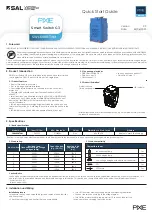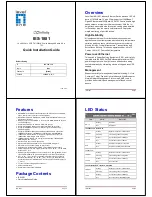
RSTP Configuration
545
Specify a Switch
as the root or
backup root
bridge
The role of the
current Switch as the
root or backup root
bridge depends on
the STP calculation.
A Switch can be made the root bridge by
specifying its Bridge preference to 0.
Configure the
Bridge
preference of a
Switch
The Bridge
preference of a
Switch is 32768.
A Switch can be made the root bridge by
specifying its Bridge preference to 0.
Specify Forward
Delay, Hello
Time, and Max
Age
Forward Delay fixes
on 15 seconds, Hello
Times on 2 seconds,
and Max Age on 20
seconds.
The other Switches copies the
configuration on the root bridge with
respect to these time parameters. You can
therefore only configure them on the root
bridge. The default values are highly
recommended.
Specify the
maximum
transmission
rate of STP
packets on a
port
No Ethernet port can
send more than 3 STP
packets within one
Hello Time.
The more STP packets a port sends within
one Hello Time, the more resources are
consumed. It is therefore recommended to
limit the transmission rate of STP packets
on a port, preferably to the default value.
Configure
whether to
connect a port
with a
peer-to-peer link
RSTP can detect
automatically
whether the current
Ethernet port is
connect to a
peer-to-peer link.
The two ports connected with a
peer-to-peer link can rapidly transit to the
forwarding status by sending synchronous
packets, eliminating unnecessary
forwarding delay.
Specify the Path
Cost on a port
Specify the
standard to
follow in Path
Cost calculation
The Switch gets the
path cost of a port
from the link rate
under the IEEE 802.1t
standard.
The path cost of a port is closely related to
the transmission rate of the link the port
connected with. The larger the link rate is,
the smaller the path cost shall be. It is
recommended to use the default
configuration.
Specify mCheck
for a port
-
You can change the operational mode of a
port from STP-compatible to RSTP.
Configure the
protection
functions on a
Switch
No protection
function is enabled
on a Switch.
It is recommended to enable the Root
protection function on the root bridge.
Switch C
and
Switch D
Enable the STP
feature on the
Switch
Enable the STP
feature on the
port
The STP feature is
disabled from the
Switch, but will be
enabled on all ports
once being enabled
on the Switch.
The configuration of STP feature status on
the port will not take effect if the STP
feature is disabled from the Switch.
Configure RSTP
operational
mode
The Switch works in
RSTP mode.
If there are Switches respectively running
STP and RSTP on the network, it is
recommended to set the Switch in
STP-compatible mode.
Configure the
Bridge
preference of a
Switch
The Bridge
preference of a
Switch is 32768.
A Switch can be made the designated
bridge of the downstream Switches by
specifying an appropriate Bridge preference
in the STP calculation.
Table 595
RSTP Configuration (continued)
Device
Configuration Default Value
Note
Summary of Contents for 5500 SI - Switch - Stackable
Page 24: ...24 ABOUT THIS GUIDE...
Page 50: ...50 CHAPTER 1 GETTING STARTED...
Page 54: ...54 CHAPTER 2 ADDRESS MANAGEMENT CONFIGURATION...
Page 78: ...78 CHAPTER 3 PORT OPERATION...
Page 88: ...88 CHAPTER 4 XRN CONFIGURATION...
Page 122: ...122 CHAPTER 8 VLAN VPN CONFIGURATION...
Page 216: ...216 CHAPTER 15 SSH TERMINAL SERVICES...
Page 268: ...268 CHAPTER 16 IP ROUTING PROTOCOL OPERATION...
Page 308: ...308 CHAPTER 17 NETWORK PROTOCOL OPERATION...
Page 349: ...349...
Page 350: ...350 CHAPTER 18 MULTICAST PROTOCOL...
Page 522: ...522 CHAPTER 22 FILE SYSTEM MANAGEMENT...
Page 584: ...584 CHAPTER 30 PASSWORD CONTROL CONFIGURATION OPERATIONS...
Page 600: ...600 CHAPTER 31 MSDP CONFIGURATION...
Page 614: ...614 CHAPTER 32 CLUSTERING...
Page 670: ...670 CHAPTER C AUTHENTICATING THE SWITCH 5500 WITH CISCO SECURE ACS...
















































